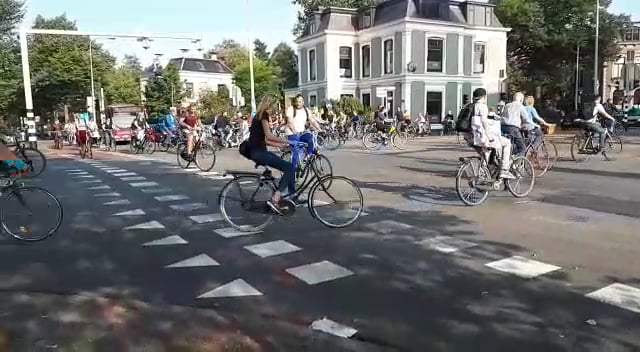It’s a quarter past five in the afternoon. At the intersection of the Stationsweg and the Hereweg, cyclists gather en masse at the traffic lights. As soon as the lights turn green – simultaneously – chaos seems to ensue.
One guy on a folding bike bypasses the group of cyclists in front of him and dashes diagonally across the intersection. On the right, a carrier bike wobbles. As a moped wades into the stream of commuters from the left, an older woman gets off her bike in the middle of the intersection, a spot of stillness in a river of motion, to wait for the chaos to pass.
These crazy Alle Richtingen Tegelijk Groen (ARTG, or Simultaneous Green) intersections are unique to the Netherlands. There are no fewer than twenty-nine of them in Groningen. When the city of Rotterdam tried to implement a similar system, there were two accidents in the first two minutes, and the alderman quickly cancelled the experiment.
Five questions and answers about Groningen intersections
1. It looks like total chaos, but almost everyone makes it safely to the other side. How does that work?
‘This is really a very safe system’, says Jaap Valkema, who works as a policy adviser of traffic with the municipality of Groningen. ‘I know it doesn’t seem like it, but on these intersections, cyclists have their own window; they don’t cross the intersection at the same time as motorised traffic.’
Nevertheless, accidents do still happen. Sometimes cyclists crash into each other or someone is bowled over by an impatient scooter driver. But that’s rare.
‘Honestly, it’s safer’, Valkema maintains. Before the system was implemented, these intersections were the scene of frequent accidents due to drivers’ blind spots. Cyclists who were going straight would be hit by trucks turning right, for example. These types of accidents are now a thing of the past.
‘When a cyclist and a car collide, there’s a much greater chance of injury than when two cyclists collide.’
2. But the experiment in Rotterdam failed almost immediately. Why?
‘The intersection in Rotterdam was much smaller than the ones in Groningen’, RUG traffic psychologist Dick de Waard says. ‘Simultaneous green intersections work best when the intersection is large and organised. It allows people to make eye contact and react in a timely manner.’
On the smaller intersection, the cyclists weren’t able to properly gain speed, which meant they crashed into the other cycling streams. ‘A few intersections in Groningen have the same problem.’
One of these is the intersection at the W.A. Scholtenstraat. It’s not quite big enough for all the cyclists cross smoothly at the same time. Cycling streams often collide on this intersection.
Another thing to remember: Rotterdam has no experience with these intersections, while the denizens of Groningen have been navigating them for ages.
3. So everyone loves them?
‘Not quite everyone’, De Waard says. ‘Especially international students and older people dislike them. They think they’re scary.’
These people will sometimes get off their bikes and wait for the stream of bikes to end. But that can mean cyclists are in the intersection after the light changes and cars are moving through. ‘There are even people who try to avoid the intersections altogether’, De Waard says.
4. I’m an international and I think crossing these intersections is super scary. What should I do?
‘Scan the intersection while you’re waiting at the lights’, says De Waard. ‘Try to figure out what you need to look out for, like a scooter or an electric bike that might accelerate really quickly.’
‘And just stay calm’, Valkema adds. ‘Give yourself time to get used to the system. The Groningen inhabitants have been doing this for thirty years, so it’s only natural if you’re a little apprehensive at first.’
5. If the system is so great, why hasn’t it been implemented in the rest of the country?
‘You tell me’, says Valkema. De Waard thinks about it for a while, but can’t come up with a good reason either. ‘Maybe because it’s only worked in Groningen so far?’




